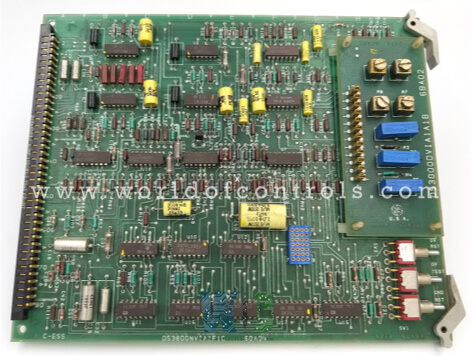
World Of Controls understands the criticality of your requirement and works towards reducing the lead time as much as possible.
DS3800NVIA - Voltage Isolator Board is available in stock which ships the same day.
DS3800NVIA - Voltage Isolator Board comes in UNUSED as well as REBUILT condition.
To avail our best deals for DS3800NVIA - Voltage Isolator Board, contact us and we will get back to you within 24 hours.
SPECIFICATIONS:
Part Number: DS3800NVIA
Manufacturer: General Electric
Series: Mark IV
Product Type: Voltage Isolator Board
System Voltage: 12 to 48 volts
Input Voltage Range: 0–10 V DC
Power Supply: 24 V DC
Size: 8.25 cm high x 4.18 cm
Minimum Operating Voltage: 8 volts
Voltage Input Range: 90 – 264 VAC
Frequency: 47 – 63 Hz Voltage Output Range
Operating Temperature: -20°C to +60°C
Mounting Type: DIN Rail Mount
Isolation Voltage: ≥ 2.5 kV
Input Impedance: > 100 k Ohm
DIN Rail Attachment: 35 mm
Repair: 3-7 days
Availability: In Stock
Weight: 0.2 kg
Country of Origin: United States
FUNCTIONAL DESCRIPTION:
DS3800NVIA is a Voltage Isolator Board manufactured and designed by General Electric as part of the Mark IV Series used in GE Speedtronic Gas Turbine Control Systems. The Current/Voltage Isolator converts high-level AC or DC and voltage signals into two low-level output signals (0 to ±10 V), which are electrically isolated from the source. This enables safe observation of signal waveforms in power circuits using a standard oscilloscope. The output signals can also serve as feedback inputs in control systems. The current output (I) provides a signal proportional to the input current, while the voltage output (E) reflects the input voltage. Both outputs can operate at the same time. This plug-in module is designed for use with the Model 8840 Enclosure/Power Supply and is automatically powered when inserted.
KEY FEATURES OF THE 4-CHANNEL OPTICAL ISOLATION MODULE:
WOC has the largest stock of Replacement Parts for GE Speedtronic Gas Turbine Control Systems. We can also repair your faulty boards and supply unused and rebuilt boards backed up with a warranty. Our team of experts is available around the clock to support your OEM needs. Our team of experts at WOC is happy to assist you with any of your automation requirements. For pricing and availability on parts and repairs, kindly contact our team by phone or email.
What type of isolation is used between input and output channels?
The module uses optocouplers (optical isolators) to achieve galvanic isolation between input and output circuits.
What is the isolation voltage rating between the input and output?
Typical isolation voltage is rated at 2.5 kV RMS (check product datasheet for exact specifications), suitable for most control and monitoring applications.
What is the maximum input current per channel?
Input current typically ranges from 5 to 15 mA, depending on the input voltage and internal LED forward voltage. Current-limiting resistors are used internally.
What is the output type and configuration?
Each output is open-drain (N-channel MOSFET), with a common pull-up rail shared across all channels. The output must be externally pulled up to a desired voltage (max 30V DC, depending on model specs).